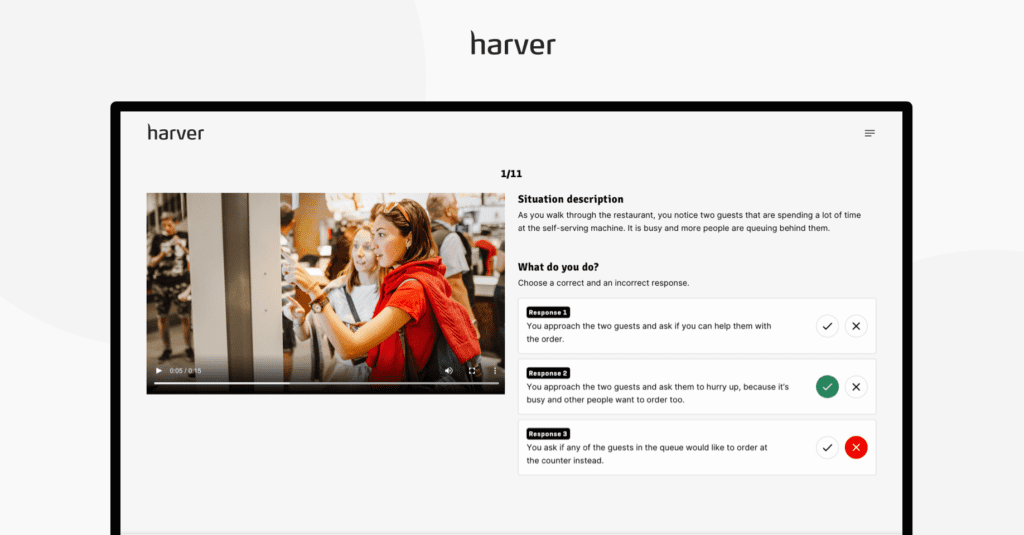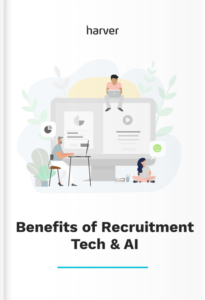With the blessings of the internet, it’s now possible to reach even the furthest corners of the world through virtual communication. So, needless to say, this opens up a wealth of opportunities for recruiters searching for the best possible candidates in their field.
Virtual recruiting has never been easier. For many companies, this process sits firmly alongside other strategies in their recruiting arsenal – not only for reaching remote candidates but also as a more convenient way of screening applicants before dishing out in-person interviews.
Whatever your reasons for dabbling in virtual hiring, worry not. Below we’ve compiled a guide outlining everything you need to know about virtual recruiting – so let’s dive in!
What’s in?
What is virtual recruiting?
In short, virtual recruiting describes a hiring process that takes place remotely, without meeting the candidates face to face. Instead, recruiters rely on technology to host video interviews, virtual events, surveys, and assessments to evaluate their applicants remotely.
The advantages of virtual recruiting
While face-to-face interviews shouldn’t be undervalued for the honest, personal connections they facilitate, virtual recruitment strategies are becoming increasingly common, especially when social distancing measures apply. So, let’s explore the advantages of virtual recruiting.
Ensuring recruiting continuity even in difficult situations
As we’ve already alluded to, COVID-19 has accentuated the need for remote hiring strategies. In many cases, this pandemic has forced entire teams to work from home. Still, by having a virtual recruitment process in place, you can continue to hire and onboard new staff.
As long as you and your applicants have a stable internet connection, it’s possible to continue filtering prospects through your recruitment funnel.
Saving time, protecting schedules
Virtual recruiting enables you to screen more candidates in a shorter amount of time – especially if you’re using one-way video interviews and online assessments. But even traditional video conversations can be scheduled much more flexibly to fit around your busy schedule.
The bottom line: Either way, you’ll save time – which is never a bad thing!
Reducing recruitment spending and interview expenses
A well-designed virtual recruiting process allows you to automate a lot of manual tasks. That way, you can streamline and optimize the entire process to ensure your funds are used effectively on finding and recruiting the best possible applicants.
In the long-run, your company will also save money on interview expenses, especially travel expenses for your out-of-town candidates.
Minimize bias and open more doors
Streamlining your virtual recruitment efforts allows for a consistent approach. This is essential for affording each candidate an equal footing and reducing common hiring biases. Some all worthy candidates will be brought to your attention that otherwise may have slipped through the net.
We’ve detailed the topic in the article below.
What’s more, a virtual hiring process allows you to access a global talent pool and recruit people from different parts of the world in an efficient way.
Like what you see?
Don’t miss out. Subscribe to our quarterly digest to get the latest TA and TM resources delivered right to your inbox.
The limitations of virtual recruiting
There are two sides to any coin – so, while virtual recruitment boasts plenty of advantages, conversely, there are valid reasons why many still prefer face-to-face interviews and wouldn’t want to stick to remote recruiting after the COVID-19 pandemic.
These drawbacks don’t necessarily discredit virtual recruiting. Instead, they pose challenges that, with careful thought and consideration, can be overcome with a hybrid approach.
With that being said, let’s take a look at some of virtual recruiting’s drawbacks.
It’s harder to gauge a culture fit
Without candidates coming into the office, introducing them to the team, and showing them around, gauging whether they complement your company culture can be a challenge.
They might accept the job only to find that your workplace environment or their team doesn’t suit them, or vice versa, and this mismatch could lead to an early exit. The misaligned candidate expectations are the cause of early attrition in many entry-level roles.
Fortunately, recruitment software such as Harver make it possible to showcase your company culture and assess the candidate-job fit before sending an employment offer.
You can learn more about the Harver cultural fit assessment below.
The candidate experience might suffer
If you’re only using virtual recruitment strategies, candidates don’t always feel as valued and engaged as they might with in-person hiring methods.
This is especially true if all your video interviews are limited to one-way communications, after all, this is somewhat of a ‘detached’ approach. So, don’t forget to brainstorm virtual recruitment ideas on how to provide an interactive experience to your candidates.
Here’s, for example, the candidate experience we built for retailer Valvoline. It includes a series of pre-employment assessments to test candidate skills, as well as company videos that showcase the culture and ensure candidates who don’t fit are filtered out before the interview stage.
And on top of your automated recruitment techniques, consider providing applicants with an avenue where they can ask questions. This helps take the edge off any aloofness associated with other virtual hiring procedures.
How to make your virtual recruitment process a success
To boost your chances of building a successful virtual recruiting process, there are a few things to keep in mind – all of which hinge on the needs, size, and capabilities of your company. Also, it almost goes without saying, the more advanced tech you have access to, the more options you’ll have available.
Here are our tips on how to recruit virtually.
Abide by the law
Whenever you use recruiting technology and collect data online, you must abide by the law. This means complying with EEOC guidelines.
Not only that, but you also need to take precautions to ensure your recruitment process is non-discriminatory as per the Equality Act. This means that at no stage should your recruitment funnel filter out candidates due to:
- Age
- Disability
- Gender
- Marital status
- Race
- Religion
One way to reduce unconscious bias is to introduce principles of blind hiring into your process such as blind resume screening. This is just one of the many ways you can eliminate prejudice from your recruitment process.
Also, if you’re recruiting in different countries, you have to make legal considerations for all of them, as local labor and privacy laws might differ. For example, if you’re recruiting in Europe, you must make sure that the recruitment tools you’re using are GDPR compliant.
Adapt your recruitment tech stack
A good virtual recruiting process is largely supported by technology and you might need to adjust your usual recruitment tech stack. Check if it has the necessary capabilities.
For example, if you’re planning to conduct one-way video interviews, does your existing tech support that or will you need to implement new software? Can you upload company videos to your assessments to introduce your organization and its culture?
Whenever you want to implement new software, make sure that it integrates with your ATS to create a seamless virtual recruitment experience for recruiters and candidates alike.
When you’re expecting higher volumes of applications, consider using chatbots as virtual recruitment assistants. Program it to answer frequently asked questions and/or redirect candidates to where they can find the help they need.
It’s an effortless way to ease your support team’s workload, and provide instant responses to applicants – win-win!
How AI & recruitment technology is changing recruiting experience
Find out how tech has helped other companies grow by enhancing both the recruiters’ and candidates’ experience!
Let candidates experience the job and the company culture
As we’ve already hinted at, virtual recruiting often doesn’t allow inviting candidates on site for a job trial or an assignment and letting them experience your workplace culture.
However, you can overcome this barrier by providing immersive virtual experiences. For instance, you could take candidates on a virtual tour of the office, have them ‘meet’ various members of the team, and get them to complete tasks that mirror the kind of work they’ll do on the job.
You should also pay special attention to your culture pitch during the interviews and come up with examples and stories to build a picture of your company culture in your candidates’ minds. You’ll get a better feel for whether the applicant is a good fit.
Likewise, the candidate can evaluate for themselves whether they’re interested in what you have to offer early on in the hiring process.
Think about ways to bring job trials or assignments in a virtual setting. This can include take-home tasks with a time limit, as well as situational judgement tests as a part of your online assessment. Here’s an example of SJT for the QSR (quick-service restaurant) industry.

Keep candidates informed every step of the way
Virtual recruitment can be an uninvolved experience, which often leaves candidates unsure about where they stand. This is usually due to a lack of personal connection and feedback. However, just because you’re using digital and remote strategies to screen potential recruits, doesn’t mean you can’t offer a human touch to the experience.
So, tackle this issue by making candidates aware of what your virtual hiring process looks like from the get-go, and what stage they’re at. Explain to them beforehand what tools you’re going to use and how they can prepare.
It’s also an excellent idea to introduce the candidate to whoever’s interviewing them. Perhaps you could organize this via email or LinkedIn? This allows the applicant to do their homework about the interviewer and often works wonders for putting the candidate’s mind at ease.
You can automate a lot of recruitment communication with candidate relationship management tools, email marketing software, or even your pre-employment testing suite. You can send your candidates relevant information based on the stage of the recruitment process they’re in, or who the hiring manager is.
Keep the lines of communication open and give candidates an option to contact you via their preferred communication channel – social media, email or phone.

58%
of recruiters said they are increasingly using social to promote their employer brand and connect with talent in the COVID-19 period.
Source: Jobvite
Transform your career events
Anything is possible with modern technology! These days, traditional career events and job fairs can be undertaken virtually. You can host anything from open office days to networking events online, providing you have the right technology and know-how to do so. Digitizing these events is a fabulous way of giving candidates an exciting insight into your company’s culture.
Not only that, but virtual hiring events tend to be cheaper and generally more accessible to larger pools of candidates than traditional in-person occasions.
Just make sure you prepare engaging content and market your event heavily beforehand to ensure a decent turnout. We recommend that you select a variety of team members to appear live throughout the event so that candidates have the opportunity to ‘meet’ your team.
It’s also a good idea to host a few Q&A sessions – we urge you to encourage discussion amongst your current staff and prospective hires. This works wonders for engaging your audience and identifying attendees who have their finger on the pulse.
Next steps
Virtual recruiting has the potential to transform your recruitment process and lets you vet and hire candidates remotely. Not only that, but it also facilitates a cheaper, faster, and more efficient hiring process, while empowering you to expand your candidate pool further than ever before.
If you’d like to see how the Harver platform can help streamline your recruitment process and facilitate virtual hiring, you can book a demo below.
Ready to transform your hiring process?



